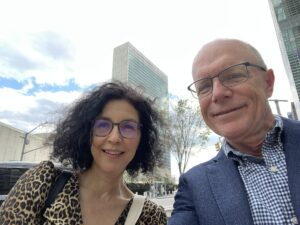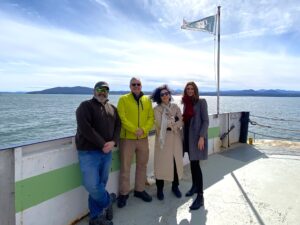
Growth, energy and progress in the USBN and strong U.S. relationships with UNESCO were highlighted in discussions between Cliff McCreedy and UNESCO representatives in mid-April in New York City. McCreedy is the U.S. government Focal Point (point of contact) with the UNESCO Man and the Biosphere (MAB) Program on behalf of the National Park Service working with the U.S. State Department. Support for U.S. involvement in the MAB program and other UNESCO programs was elevated diplomatically when the U.S. rejoined UNESCO as a member state in July 2023. McCreedy joined Meriem Bouamrane, Chief of Section for MAB Research and Policy, Ecology and Biodiversity, to review plans for involvement in the upcoming MAB International Coordinating Council in July, the World Congress on Biosphere Reserves in 2025, and other activities.
McCreedy and Bouamrane also met with Elliott Minchenberg, Director of the UNESCO New York Office. Minchenberg highlighted science and education and sustainable economic development as high priorities to elevate biosphere reserves in the U.S. and in the World Network of Biosphere Reserves. McCreedy shared that the USBN and individual biosphere regions are making significant progress in youth engagement and professional development, and in biodiversity conservation and economic development that sustains the beauty and benefits of healthy lands and water. Biosphere regions such as the Southern Appalachian, Champlain-Adirondack, Obtawaing, Cascade Head, and Golden Gate are developing science-based climate vulnerability assessment tools for communities and decision-makers to respond to climate change. Members of the USBN are participating with the international community of practice by leading CaveMAB, the international thematic group on caves and karst (Lee Anne Bledsoe, Western Kentucky University), and exchanges in the World Network of Mountain Biosphere Reserves (Kelly Cerialo, Paul Smith’s College). Minchenberg connected McCreedy with the UNESCO Chairs in the U.S., the 17 university-based chairs that engage in research and education on UNESCO themes.

Following her visit to New York City with Cliff McCreedy, Bouamrane traveled to the Champlain-Adirondack Biosphere Region in northern New York and Vermont to meet with Steering Committee members (Jim Brangan, Kelly Cerialo, Katie Darr, Jon Erickson, and Walter Polemen) and key partners in the Champlain-Adirondack Biosphere Region and learn more about their current projects and environmental stewardship. Her short but fruitful trip was meticulously planned to highlight the unique ecological and cultural heritage across the bioregion.
The trip featured visits to key partners and organizations across the bioregion including a meeting with the Lake Champlain Basin Program’s Steering Committee, tour of the ECHO Leahy Center for Lake Champlain science museum, tour of historic Shelburne Farms, a historical discussion on the Essex Ferry crossing Lake Champlain between New York and Vermont, and a lecture at the University of Vermont. Bouamrane’s discussions with local experts and community members underscored the region’s commitment to preserving biodiversity and fostering community partnerships. The visit not only strengthened the ties between local and international efforts in environmental stewardship and sustainable development, but also inspired ongoing and future projects aimed at promoting sustainable agriculture in biosphere regions.



